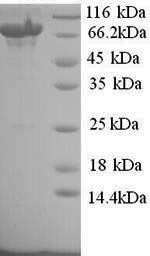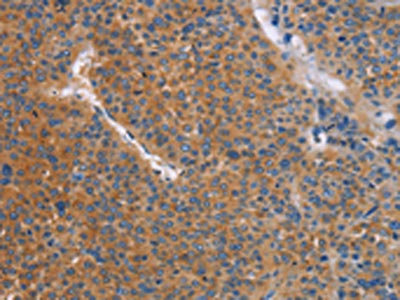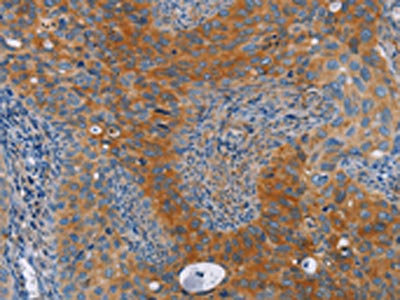Tlr8
TLR8,即Toll样受体8,别名Toll样蛋白8。它是一种在人体中由TLR8基因编码的蛋白质,属于Toll样受体家族成员之一,主要在髓样细胞如单核细胞、树突细胞和某些上皮细胞中表达。TLR8的作用机制是通过识别病原体相关分子模式,如某些细菌和病毒的核酸成分,激活下游的信号传导途径。TLR8的激活通常依赖于MyD88介导的信号通路,进而激活NF-κB、MAPK等转录因子,导致炎症介质和细胞因子的释放,从而在先天性免疫和适应性免疫中发挥关键作用 。TLR8在生物学上的意义非常广泛,它参与调节多种免疫细胞的活化、增殖和分化过程。TLR8的激活可以促进树突细胞成熟,增强其抗原呈递能力,从而激活T细胞介导的免疫应答。此外,TLR8的信号传导还与炎症反应、细胞存活和增殖等生理过程密切相关。TLR8的功能异常与多种疾病有关,包括自身免疫性疾病、慢性炎症性疾病和某些感染性疾病。因此,TLR8是免疫学研究和相关疾病治疗中的一个潜在靶点 。
热销产品
Recombinant Human Toll-like receptor 8 (TLR8), partial (CSB-YP023607HU)
验证数据

(Tris-Glycine gel) Discontinuous SDS-PAGE (reduced) with 5% enrichment gel and 15% separation gel.
验证数据

The image on the left is immunohistochemistry of paraffin-embedded Human liver cancer tissue using CSB-PA261777(TLR8 Antibody) at dilution 1/25, on the right is treated with fusion protein. (Original magnification: ×200)

The image on the left is immunohistochemistry of paraffin-embedded Human cervical cancer tissue using CSB-PA261777(TLR8 Antibody) at dilution 1/25, on the right is treated with fusion protein. (Original magnification: ×200)
Tlr8 Antibodies
Tlr8 for Homo sapiens (Human)
| 产品货号 | 产品名称 | 种属反应性 | 应用类型 |
|---|---|---|---|
| CSB-PA080187 | TLR8 Antibody | Human,Mouse,Rat | IHC, ELISA |
| CSB-PA160291 | TLR8 Antibody | Human,Mouse | ELISA,IHC |
| CSB-PA289221 | TLR8 Antibody | Human,Mouse | ELISA,IHC |
| CSB-PA268874 | TLR8 Antibody | Human | ELISA,IHC |
| CSB-PA261777 | TLR8 Antibody | Human | ELISA,IHC |
Tlr8 Proteins
Tlr8 Proteins for Mus musculus (Mouse)
| 产品货号 | 产品名称 | 来源 |
|---|---|---|
| CSB-YP023607MO CSB-EP023607MO CSB-BP023607MO CSB-MP023607MO CSB-EP023607MO-B |
Recombinant Mouse Toll-like receptor 8 (Tlr8), partial | Yeast E.coli Baculovirus Mammalian cell In Vivo Biotinylation in E.coli |
Tlr8 Proteins for Homo sapiens (Human)
| 产品货号 | 产品名称 | 来源 |
|---|---|---|
| CSB-YP023607HU | Recombinant Human Toll-like receptor 8 (TLR8), partial | Yeast |
| CSB-EP023607HU CSB-BP023607HU CSB-MP023607HU CSB-EP023607HU-B |
Recombinant Human Toll-like receptor 8 (TLR8), partial | E.coli Baculovirus Mammalian cell In Vivo Biotinylation in E.coli |











